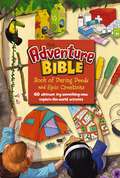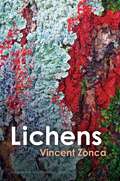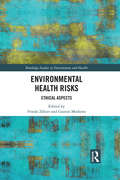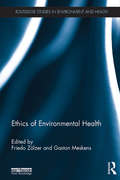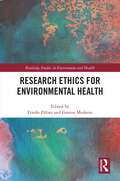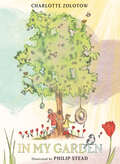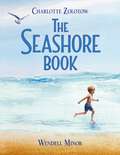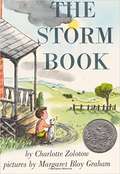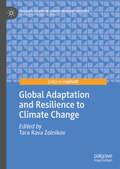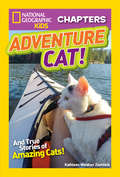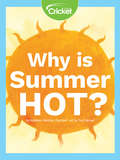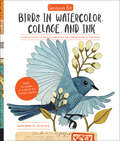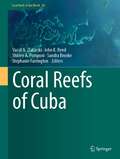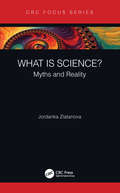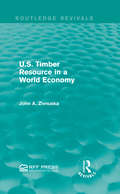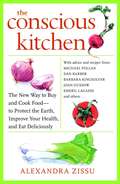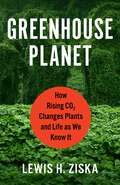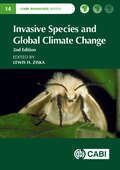- Table View
- List View
The Adventure Bible Book of Daring Deeds and Epic Creations: 60 ultimate try-something-new, explore-the-world activities (Adventure Bible)
by ZondervanBegin your adventure here! The Adventure Bible Book of Daring Deeds and Epic Creations: 60 Ultimate Try-Something-New, Explore-the-World Activities contains lessons on knot tying, writing coded letters, building tree swings, and more, perfect for kids ages 8 and up. Boys and girls will love this interactive book filled with step-by-step guides and fun, full-color illustrations, and parents will enjoy the key verses and biblical takeaways that make this the perfect companion to the NIV Adventure Bible, the #1 Bible for kids. From easy, do-it-yourself crafts to fun outdoor activities, this book will show kids how to find adventure indoors and out.Adventures include:Top-secret coded lettersGeocaching funIdentifying animal tracksCamping like a proLearning sign languageBible arts and craftsAnd more!
Lichens: Toward a Minimal Resistance
by Vincent ZoncaCovering almost 8 percent of the earth&’s terrain, lichens are living beings which are familiar to everyone, known to no one. They are one of those organisms that seem to offer nothing to hold our gaze. But the more time we spend with lichens, the more they reveal their beauty, their mysteries and their strange power of attraction. Part-algae and part-fungus, lichens call into question our customary ways of classifying forms of life, and allow us to conceive of an ecology that is no longer based on distinctions between nature and culture, urban and rural, competition and cooperation. The result of several years of investigation carried out on several different continents, this remarkable book offers an original, radical, and, like its subject matter, symbiotic reflection on this common but mostly invisible form of life, blending cultures and disciplines, drawing on biology, ecology, philosophy, literature, poetry, even graphic art. What if lichens were at the heart of some of the most pressing and topical questions of our day? Does the fact that they can live everywhere, even in very harsh environments, that they persist when almost all other traces of life have disappeared, mean that, despite their fragility, lichens are a force of resistance? After reading this book you will never see lichens, or the world, in the same way again.
Environmental Health Risks: Ethical Aspects (Routledge Studies in Environment and Health)
by Friedo Zölzer Gaston MeskensEnvironmental health involves the assessment and control of environmental factors that can potentially affect human health, such as radiation, toxic chemicals and other hazardous agents. It is less commonly understood that environmental health also requires addressing questions of an ethical nature. Bringing together work from experts across a range of sub-disciplines of environmental health, this collection of essays discusses the ethical implications of environmental health research and its application, presented at the 3rd International Symposium on Ethics of Environmental Health held in August 2016 in the Czech Republic. In doing so, it builds upon the insights and ideas put forward in the first volume of Ethics of Environmental Health, published by Routledge in early 2017. This volume will be of great interest to students and scholars of environmental health, applied ethics, environmental ethics, medical ethics and bioethics, as well as those concerned with public health, environmental studies, toxicology and radiation.
Ethics of Environmental Health (Routledge Studies in Environment and Health)
by Friedo Zölzer Gaston MeskensEnvironmental health encompasses the assessment and control of those environmental factors that can potentially affect human health, such as radiation, toxic chemicals and other hazardous agents. It is often assumed that the assessment part is just a matter of scientific research, and the control part a matter of implementing standards which unambiguously follow from that research. But it is less commonly understood that environmental health also requires addressing questions of an ethical nature. How can we determine the "acceptable" risk level for the general population or for certain groups? How should we deal with uneven distributions of risks and benefits? How do we communicate about risks with the stakeholders? This multidisciplinary collection brings together a number of leading researchers and scholars in order to generate discussion surrounding these key questions, and to bring the ethical implications of science and technology to the forefront of critical thought. Providing a broad overview of the Ethics of Environmental Health, its philosophical foundations and practical applications, this book offers a significant contribution to ongoing discussions in sustainable development and will be of interest to scholars and practitioners of Environmental Health, urban studies and healthcare.
Research Ethics for Environmental Health (Routledge Studies in Environment and Health)
by Friedo ZölzerResearch Ethics for Environmental Health explores the ethical basis of environmental health research and related aspects of risk assessment and control. Environmental health encompasses the assessment and control of those environmental factors that can potentially affect human health, such as radiation, toxic chemicals and other hazardous agents. It is often assumed that the assessment part is just a matter of scientific research, and that control is a matter of implementing standards that unambiguously follow from that research. But it is less commonly understood that environmental health also requires addressing questions of an ethical nature. Coming from multiple disciplines and nine different countries, the contributors to this book critically examine a diverse range of ethical concerns in modern environmental health research. This book will be of great interest to scholars and practitioners of environmental health, as well as researchers in applied ethics, environmental ethics, medical ethics, bioethics and those concerned with chemical and radiation protection.
In My Garden
by Charlotte ZolotowWelcome the outdoors inside for story time with this classic tale of a garden changing through the seasons.A young girl and her older companion watch birds, fly a kite, plant flowers, and play in the snow, watching flowers bloom and leaves fall as the year passes. This quiet story celebrates the simple joys found close to home, and the importance of sharing those experiences with the ones you love. A perfect story time pick for any season, In My Garden explores the natural marvels of the world around us and encourages young readers to think about what they love best throughout the year. Written by picture book master Charlotte Zolotow and originally published in 1960, this elegant reimagining of In My Garden features all-new illustrations by accomplished author-illustrator Philip Stead. His delicate illustrations and gentle, colorful palette bring new life and meaning to this classic tale-- a beautiful tribute to the experience of childhood, and a thank you to a master storyteller.
The Seashore Book
by Charlotte ZolotowA summer classic by two masters, reissued and redesigned for contemporary audiences.Wendell Minor&’s elegant artwork and Charlotte Zolotow&’s simple, evocative prose brings a day at the beach vividly to life as a boy and his mother imagine what it would be like to spend a day at the seashore. Hunting for seashells and building sandcastles, this tribute to the power of imagination and the tenderness of a mother-child connection is also a sweet ode to summer's greatest pastimes. Perfect for storytime or bedtime.
The Storm Book
by Charlotte ZolotowIt is a day in the country, and everything is hot and still. Then the hazy sky begins to shift. Something is astir, something soundless.
Global Adaptation and Resilience to Climate Change (Palgrave Studies In Climate Resilient Societies Ser.)
by Tara Rava ZolnikovThis book explores the link between climate change and resiliency on each continent of the world. It reviews how climate change affects populations, not only through environmental exposures and health outcomes, but how people live their lives. Zolnikov brings together a set of experts to offer a novel perspective on understanding climate change vulnerability alongside adaption measures being implemented. Each chapter includes an overview on how climate change will affect that continent alongside current adaptation, mitigation, and policies that seek to improve population outcomes. As a whole, the book explores why a “one size fits all” approach to promote climate change resiliency does not work; however, a global perspective can facilitate people learning from one another and facing climate change together.
Adventure Cat! (National Geographic Kids Chapters)
by Kathleen Weidner ZoehfeldJoin three fantastic felines as they embark on the adventures of their (nine) lives in this colorful Chapters book, filled with photos and fun facts. <P><P>Meet Dusty, a Siamese cat who gives the phrase "cat burglar" new meaning. Take to the seas with Skatty, a sailor and cat hero. And trek across the United States with Vladimir, a real-life cat explorer! <P><P>These amazing--and TRUE--stories are sure to keep cat lovers and adventure fans on the edge of their seats.
How Deep Is the Ocean? (Let's-Read-and-Find-Out Science 2)
by Kathleen Weidner ZoehfeldRead and find out about the deepest part of the ocean in this colorfully illustrated nonfiction picture book.The ocean covers almost three-quarters of the Earth, but how deep does it go? Put on your scuba gear and explore the ocean, from its shallowest waters to its deepest, most mysterious parts. As you dive deeper, you’ll discover glowing animals, strange creatures that don’t need sunlight to survive, and even the largest hunter in the world.With beautiful illustrations and engaging text, How Deep Is the Ocean? will guide young readers into the deepest parts of the ocean. Featuring a find-out-more section with a water-pressure experiment, a lesson in making a sounding line to learn how scientists measure the depth of the ocean, a glossary of new terms, and web research prompts, this book will begin children’s explorations of the deep sea. Both the text and the artwork were vetted for accuracy by Dr. David Gruber, real-life deep sea explorer and professor of biology and environmental science at Baruch College.This is a clear and appealing science book for early elementary age kids, both at home and in the classroom. It's a Level 2 Let's-Read-and-Find-Out, which means the book explores more challenging concepts for children in the primary grades. The 100+ titles in this leading nonfiction series are:hands-on and visualacclaimed and trustedgreat for classroomsTop 10 reasons to love LRFOs:Entertain and educate at the same timeHave appealing, child-centered topicsDevelopmentally appropriate for emerging readersFocused; answering questions instead of using survey approachEmploy engaging picture book quality illustrationsUse simple charts and graphics to improve visual literacy skillsFeature hands-on activities to engage young scientistsMeet national science education standardsWritten/illustrated by award-winning authors/illustrators & vetted by an expert in the fieldOver 130 titles in print, meeting a wide range of kids' scientific interestsBooks in this series support the Common Core Learning Standards, Next Generation Science Standards, and the Science, Technology, Engineering, and Math (STEM) standards. Let's-Read-and-Find-Out is the winner of the American Association for the Advancement of Science/Subaru Science Books & Films Prize for Outstanding Science Series.
How Mountains Are Made (Let's-Read-and-Find-Out Science 2)
by Kathleen Weidner ZoehfeldRead and find out about how mountains are made in this colorfully illustrated nonfiction picture book.A mountain might be thousands of feet high, but it can still grow taller or shorter each year. This classic picture book explores how mountains are made—including how Mount Everest grew from a flat plain under an ocean to become 29,028 feet tall.How Mountains Are Made features simple activities and fascinating cross-sections of the earth’s moving crust that clearly explain plate tectonics. Both text and artwork were vetted for accuracy by an expert in the field.This is a clear and appealing science book for early elementary age kids, both at home and in the classroom. It's a Level 2 Let's-Read-and-Find-Out, which means the book explores more challenging concepts for children in the primary grades. The 100+ titles in this leading nonfiction series are:hands-on and visualacclaimed and trustedgreat for classroomsTop 10 reasons to love LRFOs:Entertain and educate at the same timeHave appealing, child-centered topicsDevelopmentally appropriate for emerging readersFocused; answering questions instead of using survey approachEmploy engaging picture book quality illustrationsUse simple charts and graphics to improve visual literacy skillsFeature hands-on activities to engage young scientistsMeet national science education standardsWritten/illustrated by award-winning authors/illustrators & vetted by an expert in the fieldOver 130 titles in print, meeting a wide range of kids' scientific interestsBooks in this series support the Common Core Learning Standards, Next Generation Science Standards, and the Science, Technology, Engineering, and Math (STEM) standards. Let's-Read-and-Find-Out is the winner of the American Association for the Advancement of Science/Subaru Science Books & Films Prize for Outstanding Science Series.
Secrets of the Seasons: Orbiting the Sun in Our Backyard
by Kathleen Weidner ZoehfeldThe family from Secrets of the Garden are back in a new book about backyard science that explains why the seasons change.Alice and her friend Zack explore the reasons for the seasons. Alice's narrative is all about noticing the changes as fall turns into winter, spring, and then summer. She explains how the earth's yearlong journey around the sun, combined with the tilt in the earth's axis, makes the seasons happen. Alice's text is clear and simple, and experiential. Two very helpful—and very funny—chickens give more science details and further explanation through charts, diagrams, and sidebars. Packed with sensory details, humor, and solid science, this book makes a complicated concept completely clear for young readers—and also for the many parents who struggle to answer their kids' questions! "Several adults of my acquaintance . . . would find Secrets of the Seasons to be an eye-popping revelation." —John Lithgow, The New York Times Book Review
What Lives in a Shell? (Let's-Read-and-Find-Out Science 1)
by Kathleen Weidner ZoehfeldRead and find out about what lives in a shell in this colorfully illustrated nonfiction picture book.A house is a home for you, a nest is a home for a bird, and a cave is a home for a bear. But for some animals a shell is a home. Snails and turtles and crabs and clams all have shells that act as their homes and protect them from harm.This clear and appealing book for early elementary age kids, both at home and in the classroom, is a fascinating exploration of the many creatures that make a home in a shell. This picture book features beautifully accurate illustrations of the many types of shells—inside and out! Young readers will love exploring the fascinating homes of creatures like hermit crabs, scallops, and turtles.This is a Level 1 Let's-Read-and-Find-Out, which means the book explores introductory concepts perfect for children in the primary grades. The 100+ titles in this leading nonfiction series are:hands-on and visualacclaimed and trustedgreat for classroomsTop 10 reasons to love LRFOs:Entertain and educate at the same timeHave appealing, child-centered topicsDevelopmentally appropriate for emerging readersFocused; answering questions instead of using survey approachEmploy engaging picture book quality illustrationsUse simple charts and graphics to improve visual literacy skillsFeature hands-on activities to engage young scientistsMeet national science education standardsWritten/illustrated by award-winning authors/illustrators & vetted by an expert in the fieldOver 130 titles in print, meeting a wide range of kids' scientific interestsBooks in this series support the Common Core Learning Standards, Next Generation Science Standards, and the Science, Technology, Engineering, and Math (STEM) standards. Let's-Read-and-Find-Out is the winner of the American Association for the Advancement of Science/Subaru Science Books & Films Prize for Outstanding Science Series.
What Makes a Blizzard? (Let's-Read-and-Find-Out Science 2)
by Kathleen Weidner ZoehfeldRead and find out about blizzards in this colorfully illustrated nonfiction picture book.All blizzards are snowstorms, but not all snowstorms are blizzards. What is the difference? How much snow falls during a blizzard? How fast are the winds? How cold does it get during a blizzard? Read and find out! What Makes a Blizzard comes chock-full of visual aids like charts, sidebars, and hands-on activities—including how to keep a winter weather journal and how to observe what a snowflake really looks like.This is a clear and appealing science book for early elementary age kids, both at home and in the classroom. It's a Level 2 Let's-Read-and-Find-Out, which means the book explores more challenging concepts for children in the primary grades. The 100+ titles in this leading nonfiction series are:hands-on and visualacclaimed and trustedgreat for classroomsTop 10 reasons to love LRFOs:Entertain and educate at the same timeHave appealing, child-centered topicsDevelopmentally appropriate for emerging readersFocused; answering questions instead of using survey approachEmploy engaging picture book quality illustrationsUse simple charts and graphics to improve visual literacy skillsFeature hands-on activities to engage young scientistsMeet national science education standardsWritten/illustrated by award-winning authors/illustrators & vetted by an expert in the fieldOver 130 titles in print, meeting a wide range of kids' scientific interestsBooks in this series support the Common Core Learning Standards, Next Generation Science Standards, and the Science, Technology, Engineering, and Math (STEM) standards. Let's-Read-and-Find-Out is the winner of the American Association for the Advancement of Science/Subaru Science Books & Films Prize for Outstanding Science Series.
Why Is Summer Hot?
by Kathleen Weidner ZoehfeldHave you ever wondered why the days are so long in the summer and short in the winter? Or why we have hot weather and colder weather? Read on to learn about how the Earth, how it spins around the Sun, and the seasons!
Geninne's Art: Birds In Watercolor, Collage, and Ink
by Geninne ZlatkisA personal field guide to how the popular Santa Fe artist finds her inspiration and creates her charming paintings and collages of birds and nature.Brimming with inspiring examples of the artist’s work, this beautiful book takes you inside Geninne’s studio for an in-depth look at how she creates. You will discover, step by step, how this devoted artist spends time photographing nature, selecting her materials, and developing her personal imagery. Explore:How her studio is set up, how she works, and what materials and tools she usesHow she captures nature with both a camera and phone for referenceHer artistic process through the step-by-step creation of 5 watercolor paintings, 5 collages, and 5 ink drawings, with notes on each medium and techniqueAs a special bonus, the book includes 32 pages of collage papers, painted and selected by Geninne, for you to use as you explore and develop your own artistic voice.Vibrant, detailed, and richly imaginative, Geninne’s interpretation of the birds she has observed so closely will inspire you to use the natural world as fodder for your paintings, drawings, and collages.“Lovely . . . If you’re a playful artist avid about collage or ink drawing, you might be smitten.” —Arts & Activities
Coral Reefs of Cuba (Coral Reefs of the World #18)
by Vassil N. Zlatarski John K. Reed Shirley A. Pomponi Sandra Brooke Stephanie FarringtonThis comprehensive volume gathers foremost experts on the coral reefs of Cuba who represent a spectrum of disciplines, including biology, conservation ecology, economics and geology. The volume is organized along general themes including the Cuban Reef biota, reefs occurring in the Mesophotic and Eutrophic zones, ecology, conservation, management and the economic importance of the coral reefs of Cuba. The combination of case studies, new and previously published research, historical overview and examples of the ways in which research has contributed to the management and conservation of Cuban coastal resources provides a unique reference for graduate students and professionals holding a wide range of interests and expertise related to coral reef systems.
What is Science?: Myths and Reality
by Jordanka ZlatanovaIn a multitude of ways, science affects the life of almost every person on earth. From medicine and nutrition to communication and transportation, the products of scientific research have changed human life. These changes have mostly taken place in the last two centuries, so rapidly that the average person is unable to keep informed. A consequence of this "information gap" has been the increasing suspicion of science and scientists. The lack of true understanding of science, especially of "fundamental" research, motivates this effort to narrow this gap by explaining scientific endeavor and the data-driven worldviews of scientists. Key Features Fills an existing void in the understanding of science among the general population Is written in a nontechnical language to facilitate understanding Covers a wide range of science-related subjects: The value of "basic research" How scientists work by sharing results and ideas How science is funded by governments and private entities Addresses the possible dangers of research and how society deals with such risks Expresses the viewpoint of an author with extensive experience working in laboratories all over the world
U.S. Timber Resource in a World Economy (Routledge Revivals)
by John A. ZivnuskaThis book, first published in 1967, presents a concise picture of the demand and supply trends of timber around the world. Zivnuska provides a keen analysis of plans, prospects, and opportunities in the areas covered, and an interesting look at the North American forest economy. This book will be of interest to students of environmental studies and forestry.
The Conscious Kitchen: The New Way to Buy and Cook Food - to Protect the Earth, Improve Your Health, and Eat Deliciously
by Alexandra ZissuYour everyday food choices can change the world--and make meals taste better than ever For anyone who has read The Omnivore's Dilemma or seen Food, Inc. and longs to effect easy green changes when it comes to the food they buy, cook, and eat, The Conscious Kitchen is an invaluable resource filled with real world, practical solutions. Alexandra Zissu walks readers through every kitchen-related decision with three criteria in mind: what's good for personal health, what's good for the planet, and what tastes great. Learn, among other things, how to: - Keep pesticides, chemicals, and other harmful ingredients out of your diet- Choose when to spend your dollars on organic fruit and when to buy conventionally grown- Avoid plastic--including which kinds in particular and why- Figure out what seafood is safe to eat and is sustainable- Use COOL (country of origin labels) to your advantage- Determine if a vegetable is genetically modified just from reading its PLU (price look up) code- Decipher meat labels in the supermarket- Cook using the least energy--good for the earth and your wallet- Eat locally, even in winter - Understand what "natural" and other marketing terms really mean- Buy packaged foods wisely Navigate farmers' markets, giant supermarkets, and every shop in between to find the freshest and healthiest local ecologically grown and produced meat, dairy, fruits, and vegetables--no matter where you live With The Conscious Kitchen as your guide, you will never again stand in the market bewildered, wondering what to buy. You can feel confident you are making the best possible choices for you, your family, and our planet. ALEXANDRA ZISSU writes about green living, food, and parenthood. She is the author of The Conscious Kitchen, coauthor of The Complete Organic Pregnancy, and contributes the "Ask an Organic Mom" column to The DailyGreen.com. Her stories have appeared in The New York Times, The Green Guide, Cookie, Details, Bon Appétit, Self, and Health, among other publications. She is also a public speaker and "greenproofer," an eco-lifestyle consultant. Visit her website, www.alexandrazissu.com.
Greenhouse Planet: How Rising CO2 Changes Plants and Life as We Know It
by Lewis H. ZiskaThe carbon dioxide that industrial civilization spews into the atmosphere has dramatic consequences for life on Earth that extend beyond climate change. CO2 levels directly affect plant growth, in turn affecting any kind of life that depends on plants—in other words, everything.Greenhouse Planet reveals the stakes of increased CO2 for plants, people, and ecosystems—from crop yields to seasonal allergies and from wildfires to biodiversity. The veteran plant biologist Lewis H. Ziska describes the importance of plants for food, medicine, and culture and explores the complex ways higher CO2 concentrations alter the systems on which humanity relies. He explains the science of how increased CO2 affects various plant species and addresses the politicization and disinformation surrounding these facts.Ziska confronts the claim that “CO2 is plant food,” a longtime conservative talking point. While not exactly false, it is deeply misleading. CO2 doesn’t just make “good” plants grow; it makes all plants grow. It makes poison ivy more poisonous, kudzu more prolific, cheatgrass more flammable. CO2 stimulates some species more than others: weeds fare particularly well and become harder to control. Many crops grow more abundantly but also become less nutritious. And the further effects of climate change will be formidable.Detailing essential science with wit and panache, Greenhouse Planet is an indispensable book for all readers interested in the ripple effects of increasing CO2.
Invasive Species and Global Climate Change (CABI Invasives Series)
by Lewis H. ZiskaThis book addresses topics related to the impact of invasive species including biosecurity, demographics, species diversity and food security. It is meant for researchers, upper-level students, and policy makers and provides a factual basis for the underlying science and a discussion of that information with respect to current and future impacts and possible solutions. This book explores the nexus of climate change and biological invasions, resulting impacts (biological and economic) and assesses ways to reduce vulnerability and increase the resiliency and sustainability of managed and unmanaged ecosystems. The book has three parts, focusing on: (1) the dimensions of the problem; background and science; (2) case studies; (3) Management: detection, prevention, control and adaptation. This revised edition examines a wide range of topics and region, the underlying science, examples (case studies) from around the world, and ways and means to recognize, manage and control the consequences. It includes new cases and new threats; for example, a chapter summarizing case studies regarding climate change and invasive species that are also disease carriers (e.g. ticks and Lyme disease). - Covers a wide range of topics and areas - Examines the synergy between invasive species and climate change - Explains options to control and mitigate effects This book is of interest to academics, researchers and students studying climate change and invasive species. Those interested in the environment and ecology, land managers, policy makers, agronomists, federal and state departments of natural resources, climate change activists, public health professionals.
Environmental Practice and Early American Literature
by Michael ZiserThis original and provocative study tells the story of American literary history from the perspective of its environmental context. Weaving together close readings of early American texts with ecological histories of tobacco, potatoes, apples, and honey bees, Michael Ziser presents a method for literary criticism that explodes the conceptual distinction between the civilized and natural world. Beginning with the English exploration of Virginia in the sixteenth century, Ziser argues that the settlement of the "New World" - and the cultivation and exploitation of its bounty - dramatically altered how writers used language to describe the phenomena they encountered on the frontier. Examining the work of Harriot, Grainger, Cooper, Thoreau and others, Ziser reveals how these authors, whether consciously or not, transcribed the vibrant ecology of North America, and the ways that the environment helped codify a uniquely American literary aesthetic of lasting importance.
